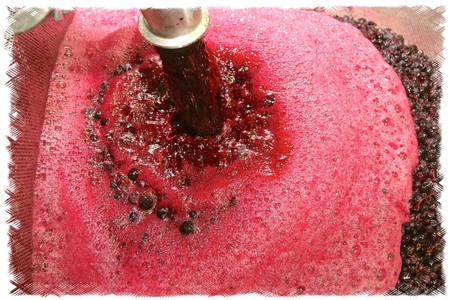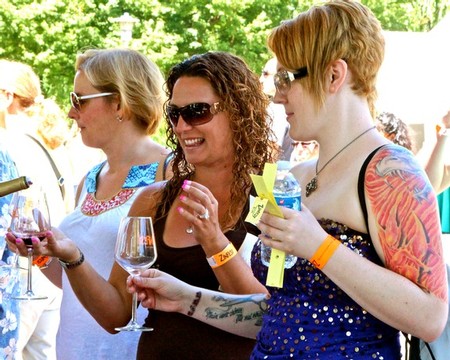Letters from Lodi
An insightful and objective look at viticulture and winemaking from the Lodi
Appellation and the growers and vintners behind these crafts. Told from the
perspective of multi-award winning wine journalist, Randy Caparoso.
Why consumers never needed experts to tell them what they like (like Elvis and Zinfandel)
What do Zinfandel and Elvis have in common (read on!)
Why are some wines far more popular than others?
The other day on a social media post I saw this question posed on my shared thread: Why isn't Port very popular in the U.S.?
First, this is the current Wikipedia definition of Port: "Port wine is a Portuguese fortified wine [i.e., bolstered by the addition of brandy, raising alcohol levels to 19%-20%] produced in the Douro Valley of northern Portugal. It is typically a sweet red wine, often served as a dessert wine, although it also comes in dry, semi-dry, and white varieties."
Back to the social media question: The obvious answer for why Port is not very popular with consumers, at for least the vast majority of consumers, is that most people just don't like drinking wines that are
• Very sweet (most Ports are even sweeter than even the most popular medium-sweet table wines, like White Zinfandel and Moscato), and
• High in alcohol (most table wines that we drink today are between 12% and 15% alcohol — that extra +5% in Ports makes a huge difference).

Fermenting Lodi-grown Zinfandel juice being pumped over skins in a tank
Anyone who has tasted a Port before would instinctively know that heavier, sweeter wines are a lot more filling than lighter, dry, or off-dry wines, and therefore not as pleasant for simply sitting around and sipping from the glass, or to compliment the foods we usually like to eat, like pasta, chicken, steak, seafood, salads or pizza. It's really that simple.
I noticed, however, that on this particular social media post a well-known, published wine critic jumped into the conversation. In his opinion, he wrote, Port is not popular "because people just don't know Port." He also suggested that "many Ports are not as sweet as people think" — implying that consumers are largely unaware of this fact, which explains their lack of appreciation of Ports.
This esteemed wine critic's point was well taken. He spends, after all, most of his time in Portugal covering these wines — his knowledge of Port is intimate and masterly. All the same, I couldn't help but think that he was also missing the most rudimentary point, which is that consumers really don't need to have Port explained to them by anyone in the wine industry, trade, or media. They know they prefer lighter table wines.

Tom Hoffman, Lodi winemaker/grower (Heritage Oak Winery), who is also a talented pianist
Consumers are, simply put, pretty damned smart. They are "smart," however, in ways that are different from, say, a professional wine critic's smarts. They are smarter, for instance, when it comes to knowing what they like, which is not much different than the way consumers appreciate any commercial product associated with some degree of artistry (and as Robert Mondavi said long ago, wine is the "perfect blend of art and science").
Mozart and Beethoven, for instance, are considered two of the greatest composers who ever lived. Nonetheless, the best-selling musicians of all time are The Beatles, Elvis Presley, and Michael Jackson. You can throw in Madonna, Led Zeppelin, Taylor Swift, Garth Brooks, or Rihanna into any list of music that people love and appreciate the most. Does this make people "dumb?" Or prove that they can't appreciate Mozart and Beethoven sufficiently enough because they just "don't know" them well enough? Of course not. It simply means we find The Beatles, Elvis, Garth, and Swift more appealing.

Wine lovers at a past Lodi ZinFest
Consumer preferences, in many ways, have always reflected something amounting to genius — at least from the perspective of having an inherent, as opposed to learned, ability to recognize what is and what isn't. When music, like other artistic endeavors, is really and truly great, there is bound to be popular acclaim. By the same token, when music is mediocre, it goes nowhere. Music is often very good, but not catchy enough for you to want to listen to it all day or while cruising down a highway. Either way, a consumer knows what's up.
It is the same for literature, fashion, the arts, and many crafts. It is also true for wines, which are not just crafted or manufactured products, but also the culmination of a considerable amount of thought, time, and effort devoted to meticulously cultivated plants. A perfect blend, in that sense, of not just art and science, but also hardscrabble farming. In the end, a wine must be appealing, and it is the most appealing wines that end up being what we demand the most. Ultimately, this also determines what is actually planted the most in vineyards.
Ergo, it is not the hard-working farmers or even the geniuses in the wine industry (much less wine media) who determine what is grown, made, and appreciated. It's always been the consumers, and their sensory predilections, who lead the way.

Name that Lodi Zinfandel specialist! (from left-right/top-bottom: McCay Cellars' Mike McCay, Harney Lane Winery's Kyle Lerner, Michael David Winery and Mettler Family Vineyards' Adam Mettler, St. Amant Winery's Stuart Spencer, and Maley Bros.'s Todd Maley)
The historical context of Zinfandel
You can better understand this process by taking a cursory glance at the history of wine growing. In the 1850s, for example, after California had just become a state and people were pouring in from all over the world to either strike it rich in the goldmines or to settle in on promising new land. Settlers of European descent were, of course, wine drinkers. It was in their blood, but they had no idea of what grapes grow best in their adopted country. So they planted dozens upon dozens of different varieties, imported from all over Europe — especially France, Italy, Spain, Portugal, and Germany.
Out of all those grapes, one of them emerged as the most amenable to California's climate (largely Mediterranean) and soils, and also consistently produced the best-tasting wine, whether grown in the hillsides of Napa Valley or Sonoma County, up on the ridgetops of Mendocino or the foothills of the Sierra Nevada, on the flat, rich, sandy soils of Lodi and even as far south as Los Angeles and Santa Cruz Island off the coast of Santa Barbara. That grape was Zinfandel.
By 1888, according to the ZAP (Zinfandel Advocates & Producers) website, over two-thirds of all California vineyards were planted to Zinfandel. We know that by the 1860s, El Pinal Winery in Stockton was contracting farmers in the Lodi area to plant a wide range of grapes with cuttings furnished from the El Pinal nursery, stocked with dozens of different grapes brought in each year from nurseries in Boston. In his book Zinfandel: A History of a Grape and Its Wines, Charles Lewis Sullivan writes that in 1883 an El Pinal Zinfandel was submitted to a viticultural convention in San Francisco. Lodi's oldest existing Zinfandel planting today, in Jessie's Grove's Royal Tee block, was originally planted in 1889.

Rows of Zinfandel originally planted in the 1890s in Lodi's Peirano Estate
Why Zinfandel? Was it simply because they "didn't know" enough about grapes like Cabernet Sauvignon, Chardonnay, Pinot noir, Riesling, Tempranillo, Touriga Nacional, Sangiovese or Nebbiolo to fully appreciate them? No. In fact, they tried all of those grapes plus many more. Everywhere you go around the world, the finest and most appealing wines are always the ones made from varieties that have adapted the most seamlessly to their respective environments. After going through their own process of elimination, the earliest California grape growers had enough common sense to recognize what grew and tasted the best, and therefore what sold the most to those pesky consumers — and it was Zinfandel.
Zinfandel, in fact, was not even a well-known entity when it became the preferred cultivar, but rather a "mystery" grape. The nineteenth-century Californians planting it up and down the state had no idea where it came from — this was something that wouldn't be "discovered" by U.C. Davis researchers until the 1970s (when they finally began to suspect that Zinfandel originated in Croatia) — but that did not keep the pioneers from recognizing the grape's benefits. For all intents and purposes, by the end of the 1800s, Zinfandel was firmly established as "California's grape."
Zinfandel to the nineteenth-century settlers, you can say, was like Beatlemania in the '60s. When it came out, almost out of "nowhere," no one had to tell anyone that this was the real thing. And not just any ol' thing, but possibly the best that ever was. Something you just know.

Sheep grazing among old vine Zinfandel in Lodi's Schulenburg Vineyard
When White Zinfandel was an innovative rarity
As it turned out, grapes like Zinfandel have also reflected the wisdom of consumers in different ways. At the start of the 1970s, for instance, a handful of tiny, handcrafted California producers — in those days they were called "boutique" wineries — started fooling around with small batches of off-white, pinkish wine made from Zinfandel, which they made by separating the skins of the grape (where all the pigments are contained) from the fermenting juice right after the grapes were crushed. They started calling this "White Zinfandel" because it could be appreciated chilled, like white wines. No one, outside of regular customers of these small wineries, even knew about this new-fangled style of Zinfandel. During those early years, it definitely remained experimental — something bold and daring.
The idea of making a "white" wine from the black-skinned Zinfandel grape, in fact, actually dated back to the late 1860s, when Stockton's El Pinal Winery, which sourced most of its grapes from the Lodi area, began producing a pinkish wine from Zinfandel that could be consumed like a white wine. Around the same time in Sonoma Valley, Buena Vista Winery is said to have produced white wines from Zinfandel, primarily for sparkling wine production; and in the 1880s Charles Wetmore, the Secretary of the California Viticultural Commission (and also the founder of Livermore Valley's Cresta Blanca Winery), publicly espoused the use of Zinfandel to produce a "white" wine.

Ancient vine Zinfandel dating back to 1889 in Jessie's Grove's Royal Tee block
Like other wineries experimenting with this innovation in the early '70s, Napa Valley's Sutter Home Winery started off by making bone-dry, white-ish wines from Zinfandel. They labeled it Oeil de Perdrix ("Eye of the Partridge"), as a way of describing the wine's pale salmon color. In 1975, however, one of Sutter Home's batches had a stuck fermentation. That is, the wine stopped fermenting before all the grape sugars were converted to alcohol, leaving a wine that remained perceptively sweet and, as a result, lighter in alcohol. Rather than pour the wine with its unintended residual sugar down the drain, the winery decided to bottle and sell it in the tasting room. It sold like hotcakes. Being no dummies, afterward, they decided to make all their White Zinfandels in that same light, easy, fruity-tasting way, and they took that all the way to the bank.
Needless to say, the entire California industry caught on to what Sutter Home was doing, and so by the early 1980s, dozens of other wineries were producing similar wines. Within the space of ten years, White Zinfandel went from being a rare, boutique wine to the top-selling wine category in the nation. What helped, as it were, was the fact that at the start of the 1970s, Zinfandel was still the second most widely planted grape in California (after Carignan — in those days, grapes like Cabernet Sauvignon and Pinot noir were barely among the top 10). It was a perfect way to make use of a plentiful grape, already embraced so readily by farmers and consumers for over a century.

The pervasive wisdom of consumers
Lodi growers, who have always crushed close to 40% of the state's total Zinfandel crop each year, did especially well during the 1980s and 1990s, at the height of the White Zinfandel craze. In recent years, however, Cabernet Sauvignon, Chardonnay, Merlot, and Pinot Noir have surpassed Zinfandel in total planted acreage in California, reflecting the steady evolution of Americans' tastes in wine.
In Lodi, Zinfandel has remained the most widely planted grape in the region despite a reduction in total acreage (to 15,943) from a high of 20,192 acres in 2000. In terms of annual crush, Lodi's tonnage is second only to that of Lodi-grown Cabernet Sauvignon. Elsewhere around the state, Zinfandel acreage has been drastically reduced everywhere except in Amador County, where plantings have increased over the past 40 years.

Zinfandel may grow well in all parts of California, but it has always been grown the easiest in Lodi's deep sandy soils and under the region's cloud- and fog-free summer skies. Hence the reason why Lodi has pretty much always grown more Zinfandel than the four other major California Zinfandel regions (Sonoma County, Sierra Foothills, Paso Robles, and Napa Valley) combined, plus another 33%.
When all is said and done, American consumers have always been the wisest to their own tastes. For well over 100 years, they have never needed wine critics or wine professionals to tell them what they should be drinking, even if, over the past decade, their tastes have leaned steadily towards dryer and dryer wines. Medium-sweet White Zinfandel is still popular, but not nearly as much as it was 20 years ago; and most of Lodi's Zinfandel acreage, as in other parts of California, now goes into red wines as opposed to pinks.
While varietal categories like Cabernet Sauvignon, Chardonnay, Pinot noir, and Sauvignon blanc are among today's best sellers, in all likelihood Zinfandel will retain its place in California despite the fact that in Europe, where it originated, it remains what it's always been over there — a "nothing" grape, not even an afterthought. There are hundreds of other wine varieties that are far more preferred in the European wine regions where wine growing first started. Zinfandel is a California peculiarity.

Zinfandel is here to stay, though, because it is perfectly suited to the sun-soaked, diurnal temperature ranges that define most of California's wine regions. You could say that the nineteenth-century pioneers discovered this somewhat "by accident," but that would not be giving them enough credit. They arrived at Zinfandel in the same way that the Bordelais arrived at Cabernet Sauvignon and Merlot, or the Burgundians with Pinot noir and Chardonnay, centuries and centuries ago: through laborious effort, astute observation, and intellectual rigor. Their decisions were driven by practicality, as well as the demands of the only factor that has ever really mattered: the tastes of consumers who actually drink these wines. It's like Elvis, John, Paul, George, Ringo, and Michael. The public chooses its "kings."
Because no matter what anyone says, consumers are invariably the wisest arbiters of not only their own tastes but also of what makes the most sense for the wine industry to grow and produce.

Wintering ancient vine Lodi Zinfandel, originally planted in 1904, in Harney Lane Winery's Lizzy James Vineyard
